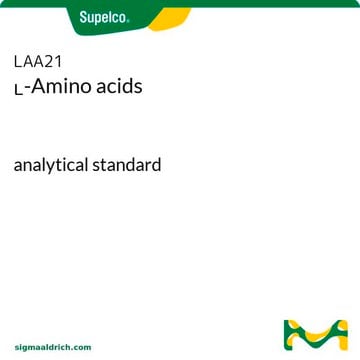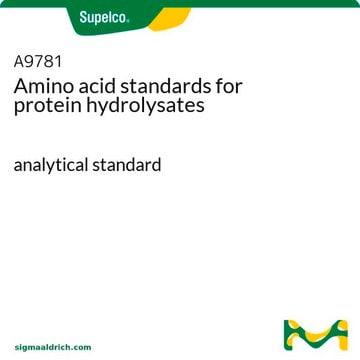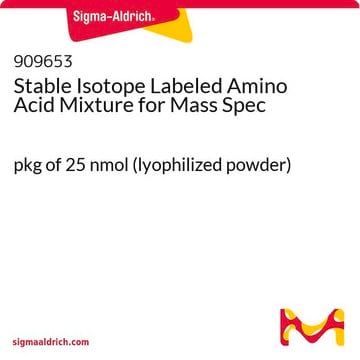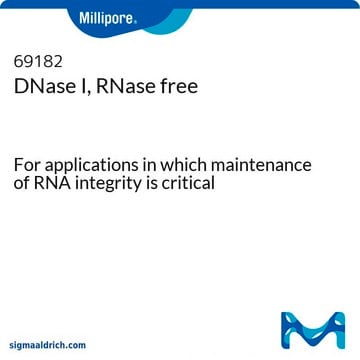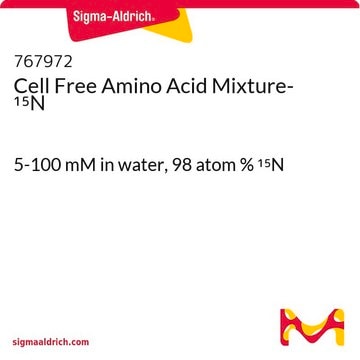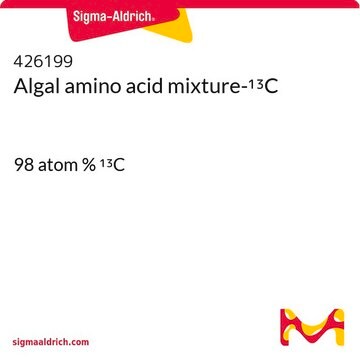79248
Amino Acids Mix Solution
certified reference material, TraceCERT®, Manufactured by: Sigma-Aldrich Production GmbH, Switzerland
Sign Into View Organizational & Contract Pricing
All Photos(1)
About This Item
UNSPSC Code:
41116107
eCl@ss:
32160406
NACRES:
NA.24
Recommended Products
grade
certified reference material
TraceCERT®
Quality Level
product line
TraceCERT®
form
liquid
shelf life
limited shelf life, expiry date on the label
analyte chemical class(es)
amino acids, peptides, proteins
manufacturer/tradename
Manufactured by: Sigma-Aldrich Production GmbH, Switzerland
technique(s)
HPLC: suitable
gas chromatography (GC): suitable
application(s)
food and beverages
format
multi-component solution
storage temp.
−20°C
General description
This certified reference material (CRM) is produced and certified in accordance with ISO/IEC 17025 and ISO 17034. This CRM is traceable to primary material from an NMI, e.g. NIST or NMIJ.
Certified content by quantitative NMR incl. uncertainty and expiry date are given on the certificate.
Download your certificate at: http://www.sigma-aldrich.com.
Refer to the product′s Certificate of Analysis for more information on a suitable instrument technique. Contact Technical Service for further support.
Check out the entire portfolio of our amino acids certified reference materials (CRM)
Certified content by quantitative NMR incl. uncertainty and expiry date are given on the certificate.
Download your certificate at: http://www.sigma-aldrich.com.
Refer to the product′s Certificate of Analysis for more information on a suitable instrument technique. Contact Technical Service for further support.
Check out the entire portfolio of our amino acids certified reference materials (CRM)
Application
It is intended to be used in the calibration of liquid chromatography, spectrophotometry, or any otheranalytical techniques.
Features and Benefits
- Produced and certified under ISO/IEC 17025 and ISO 17034 accreditation
- All the 17 amino acids are traceable to NIST SRMs
- Accompanied by a comprehensive Certificate of Analysis (CoA) (up to four pages) with data on stability, density, homogeneity, the accuracy of concentration, uncertainty, and traceability
- Gravimetrically prepared using high-quality qNMR-characterized starting materials and qualified precision balances to ensure minimal uncertainty
- Rigorously tested through real-time stability studies to ensure accuracy and shelf life
- Available in a well-sealed glass ampule to prevent contamination
Analysis Note
17 amino acids in 0.1M hydrochloric acid
2.5 mM each: alanine, arginine, aspartic acid, glutamic acid, glycine, histidine, isoleucine, leucine, lysine, methionine, phenylalanine, proline, serine, threonine, tyrosine, valine
and 1.25mM cystine
2.5 mM each: alanine, arginine, aspartic acid, glutamic acid, glycine, histidine, isoleucine, leucine, lysine, methionine, phenylalanine, proline, serine, threonine, tyrosine, valine
and 1.25mM cystine
Legal Information
TraceCERT is a registered trademark of Merck KGaA, Darmstadt, Germany
related product
Product No.
Description
Pricing
Signal Word
Warning
Hazard Statements
Precautionary Statements
Hazard Classifications
Met. Corr. 1
Storage Class Code
8A - Combustible corrosive hazardous materials
WGK
WGK 1
Flash Point(F)
Not applicable
Flash Point(C)
Not applicable
Choose from one of the most recent versions:
Already Own This Product?
Find documentation for the products that you have recently purchased in the Document Library.
Customers Also Viewed
Megumi Kato et al.
Analytical sciences : the international journal of the Japan Society for Analytical Chemistry, 33(11), 1241-1245 (2017-11-14)
To prepare metrologically traceable amino acid mixed standard solutions, it is necessary to determine the stability of each amino acid present in the mixed solutions. In the present study, we prepared amino acid mixed solutions using certified reference standards of
Liane Wagner et al.
Foods (Basel, Switzerland), 9(8) (2020-08-14)
The adulteration of fresh turkey meat by the undeclared addition of protein hydrolysates is of interest for fraudsters due to the increase of the economic gain by substituting meat with low cost ingredients. The aim of this study was to
Jindong Zan et al.
Science (New York, N.Y.), 364(6445) (2019-06-15)
Chemical defense against predators is widespread in natural ecosystems. Occasionally, taxonomically distant organisms share the same defense chemical. Here, we describe an unusual tripartite marine symbiosis, in which an intracellular bacterial symbiont ("Candidatus Endobryopsis kahalalidefaciens") uses a diverse array of
Our team of scientists has experience in all areas of research including Life Science, Material Science, Chemical Synthesis, Chromatography, Analytical and many others.
Contact Technical Service
